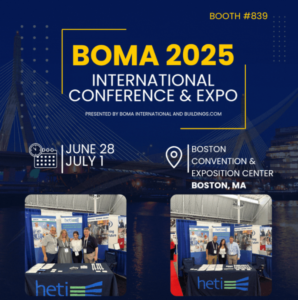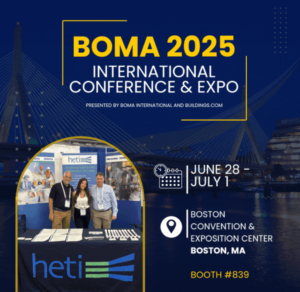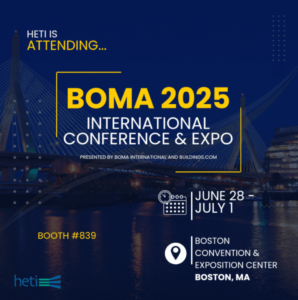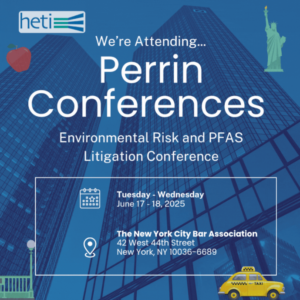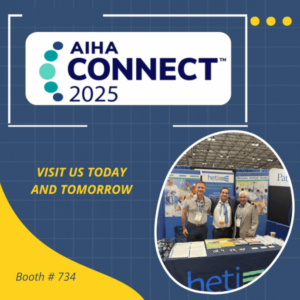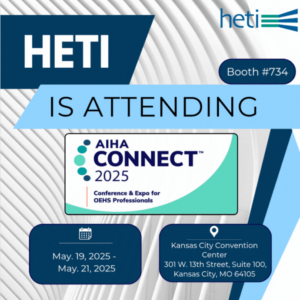Day 2 at BOMA Boston is underway! The HETI team is ready to dive into your EHS challenges—from due diligence to remediation and regulatory compliance. Stop by booth #839 to say hello and explore how we can support your next project!
Author: Kim Stachowicz
Vapor Intrusion: An Overview
Vapor intrusion (VI) occurs naturally as volatile or semi-volatile contaminants emit from soil, groundwater, or their interface and impact the interior space of buildings above. This impact can occur directly, such as when contaminated groundwater flows into a basement sump pit, or indirectly, where soil gas carrying vapor-phase contaminants is pulled into the building through plumbing and electrical chases. The types of chemicals can include:
- Volatiles: hydrocarbons (e.g., gasoline), solvents (e.g., toluene)
- Semi-volatiles: perchloroethylene, diesel fuel, creosote, etc.
- Metals: mercury, etc.
- Inorganic gases: radon, ammonia, etc.
Once inside a building, occupants can be exposed to these vapors, and, in some cases, at levels that could be hazardous. As a result of these potential exposures, federal and state regulatory agencies have moved to provide resources for building owners, occupants, and technical experts to assess risk and control exposures.
State of Regulation
The United States Environmental Protection Agency (USEPA), as well as nearly all state governments and the District of Columbia, currently provide general guidance for assessing and controlling VI in homes and businesses. However, some states, such as Massachusetts, New Jersey and Pennsylvania, do have more specific regulations regarding protocols for testing structures close to any known subsurface contamination. These regulations indicate that when subsurface concentrations of volatiles are known to exist above an established level (typically called a “screening level”), then nearby buildings should be tested to determine if VI is occurring.
Other regulations will apply to VI, such as those regarding limits of subsurface contamination. In addition, state agencies can compel VI assessments. Also, if VI impacts a commercial or industrial building, the Occupational Safety & Health Administration (OSHA) Permissible Exposure Limits and Short-Term Exposure Limits apply to the occupants.
For example, in the case of gasoline-contaminated shallow soils, causing VI in a warehouse, the owner of the warehouse is obligated to ensure that the employees therein are safe. Gasoline is a volatile mixture of dozens of chemicals, including benzene, toluene, xylene, hexane, etc., each with its own exposure limit. Proper indoor air assessment will determine which chemicals are present, and if any are found in concentrations above the OSHA limits, controls will have to be instituted to ensure worker safety.
For residential structures, the most relevant exposure limits are Reference Doses (RfDs) established by USEPA. Although some RfDs are contested as being overly conservative, these limits are extrapolated from published, peer-reviewed toxicology studies, and establish a limit below which exposure is safe to an average human continuously for 70 years.
Technology to Assess and Control Intrusion
Assessing the presence of VI can be a difficult proposition. Typically, the interior of a potentially affected building is tested over a minimum 24-hour period using various methodologies. For example, if a subsurface contamination plume intersecting a building is composed of diesel fuel, which contains dozens of potentially hazardous chemicals, USEPA’s sampling and analysis method TO-15 is often employed. This method can detect hundreds of chemicals at very low concentrations. TO-15 requires that samples be placed on the floor of the lowest level when possible, to detect chemicals as they enter the building airspace. They are also often located close to penetrations in the foundation, such as pipes, electrical wires, or sump pits.
In addition, testing below the foundation could be appropriate, especially in locations where multiple contamination plumes may be present. This is typically accomplished by installing soil vapor probes through the foundation and then testing the air entering the probes at various depths to determine what chemicals are entering the building above.
If vapors are detected above established human safety levels, there are several ways to mitigate them. Most common is a “radon fan” – which can intercept vapors before they enter the building – consisting of a tube or pipe running from beneath the building’s foundation to, typically, above the roofline of adjacent buildings. An electric fan installed in the system pulls the vapors from the subsurface and vents them into open air, bypassing the interior of the building.
In extreme cases, or with new construction in an area with known potential for VI, a vapor barrier can be installed beneath the building’s foundation to prevent vapors from entering the building. Typically a thick plastic sheeting is installed in a continuous layer below the foundation as a vapor barrier. A permeable layer of sand or similar material may be installed above the barrier to allow a concrete foundation to cure and age more evenly, or below the barrier to prevent the buildup of vapors below the building. Note that these vapor barriers will also prevent subsurface moisture vapor from entering the building, preventing moisture damage to any floor coverings or finishes.
In cases where VI potential is high, both referenced technologies can be employed in conjunction with each other to ensure that healthy indoor air quality levels are maintained. No matter what control measure is installed, the building should be tested regularly to ensure that the system functions properly.
HETI…Helping Manage Vapor Intrusion
Vapor intrusion can be a serious concern for any building near subsurface contamination. Testing the building and the subsurface are critical to determine the presence of vapors that may require control.
HETI’s staff of geologists, environmental professionals and industrial hygienists has many years of experience assessing and managing vapor intrusion. We are available to provide valuable technical support to our clients with testing, assessment and establishing appropriate engineering controls, as needed.
For further information about this and other HETI environmental health & safety services, please contact us.
Patrick A. Walsh, CIH Senior Industrial Hygienist
Phone: 978.263.4044 development@hetiservices.com
BOMA 2025 – Boston
Image
HETI is live at our booth today at BOMA Boston at the Convention & Exhibition Center! Stop by Booth #839 to meet the team and learn how we help clients with environmental due diligence, remediation strategies, and regulatory compliance. Let’s talk solutions!
BOMA 2025
Image
We’re excited to announce that HETI is exhibiting at BOMA 2025 in Boston from June 28–July 1! Come find us at Booth #839 at the Boston Convention & Exhibition Center to meet our team and learn how we help the commercial real estate industry with expert environmental and engineering solutions. Stop by and say hello—we’d love to connect!
Perrin Conferences 2025
Image
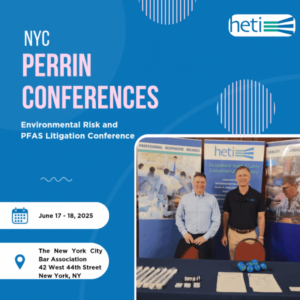
We’re in NYC for Day 1 of Perrin Conferences’ Environmental Risk and PFAS Litigation Conference! Stop by our booth to discuss how HETI helps companies stay ahead of environmental risks and navigate complex challenges with confidence. Looking forward to great conversations and new connections. See you there!
Perrin Conferences – Environmental Risk and PFAS Litigation 2025
Image
We’re excited to share that HETI will be attending The Perrin Conferences’ Environmental Risk and PFAS Litigation Conference on June 17–18, 2025, at the New York City Bar Association. We’re looking forward to connecting with industry leaders, sharing insights, and highlighting how HETI helps organizations manage environmental risk. Looking forward to great conversations—see you there!
ACG DealFest Northeast 2025
Image
We are excited to be at ACG Boston DealFest Northeast at the Boston Convention & Exhibition Center!
Come find us in the Attendee Lounge—we’d love to connect and share how HETI helps clients navigate environmental due diligence with confidence. Let’s connect, collaborate, and build something great together.
ACG Boston DealFest Northeast 2025
Image
HETI is attending ACG Boston DealFest Northeast on June 11th at the Boston Convention & Exhibition Center.
Stop by our booth in the Attendee Lounge to network with our team and learn how HETI can support your environmental due diligence and consulting needs. We’re looking forward to great conversations and new connections. See you there!
AIHA Connect 2025
We’re at the AIHA Conference & Exposition now through Wednesday at Booth #734! Stop by to connect with the team, network with industry professionals, and learn more about how we’re supporting safer, smarter decisions in environmental health and industrial hygiene.

